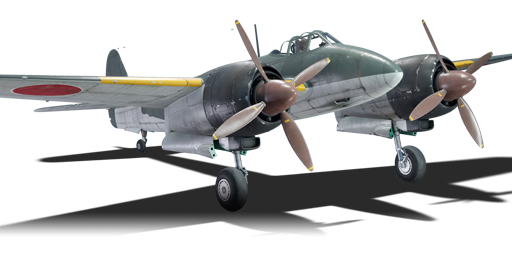




The J5N1, designated as the Tenrai (天雷), was a Japanese prototype twin-engine fighter aircraft that was developed out of the J1N1 to meet a new requirement from the Japanese Navy in early 1943. Requested to pack heavy armament, high altitude, and speed to deal with potentially dangerous bomber aircraft being developed, which Japanese intelligence is wary of (being the B-24, B-29, etc.). With the design proposal drawn up by Nakajima theoretically meeting the Navy's requirement, the Navy approved the development of the now-designated Tenrai aircraft. However, with six prototypes built, the Tenrai never hit the speed mark through multiple engine configurations, had several technical issues, and, with the high demand of the Navy, was overweight on features to achieve its full potential.
It was introduced in Update 1.89 "Imperial Navy". Excelling in its role as a high-altitude twin-engine aircraft, it packs heavy armament as requested and is fairly manoeuvrable for its size. Altitude is key, and the Tenrai should remain on top of the whole battle at all times, Boom-n-Zooming aircraft beneath it and shredding bombers before they get near their targets.
flaps
flaps
flaps
brake
| Belt | Belt filling | Armor penetration (mm) at a distance: | |||||
|---|---|---|---|---|---|---|---|
| 10 m | 100 m | 500 m | 1000 m | 1500 m | 2000 m | ||
| HEF/HEF-I/HEF-T/APHE | 38 | 36 | 28 | 21 | 16 | 12 | |
| HEF-T/HEF-I/APHE/HEF/HEF | 38 | 36 | 28 | 21 | 16 | 12 | |
| HEF-T/APHE/APHE/APHE | 38 | 36 | 28 | 21 | 16 | 12 | |
| HEF-T | 5 | 5 | 4 | 3 | 3 | 3 | |
| HEF | 5 | 5 | 4 | 3 | 3 | 3 | |
| Belt | Belt filling | Armor penetration (mm) at a distance: | |||||
|---|---|---|---|---|---|---|---|
| 10 m | 100 m | 500 m | 1000 m | 1500 m | 2000 m | ||
| T/FI/FI/APHE | 26 | 24 | 17 | 10 | 6 | 4 | |
| HEF-T/HEF/HEF/APHE | 26 | 24 | 17 | 10 | 6 | 4 | |
| APHE/APHE/APHE/APHE/HEF/HEF-T | 26 | 24 | 17 | 10 | 6 | 4 | |
| HEF-T | 4 | 4 | 3 | 3 | 3 | 3 | |
| HEF/HEF/HEF/APHE/APHE | 26 | 24 | 17 | 10 | 6 | 4 | |












Flight performance | |
|---|---|
Survivability |
|---|
Weaponry | |
|---|---|